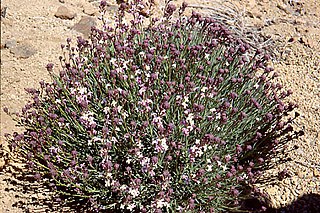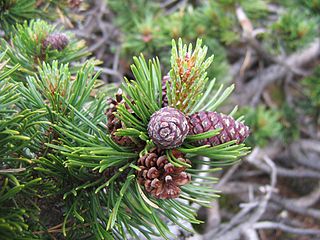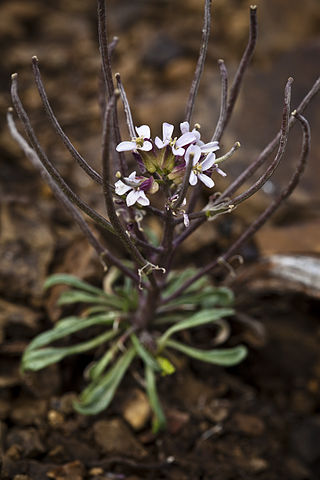
Arabidopsis (rockcress) is a genus in the family Brassicaceae. They are small flowering plants related to cabbage and mustard. This genus is of great interest since it contains thale cress, one of the model organisms used for studying plant biology and the first plant to have its entire genome sequenced. Changes in thale cress are easily observed, making it a very useful model.

Erysimum, or wallflower, is a genus of flowering plants in the cabbage family, Brassicaceae. It includes more than 150 species, both popular garden plants and many wild forms. The genus Cheiranthus is sometimes included here in whole or in part. Erysimum has since the early 21st century been ascribed to a monogeneric cruciferous tribe, Erysimeae, characterised by sessile, stellate (star-shaped) and/or malpighiaceous (two-sided) trichomes, yellow to orange flowers and multiseeded siliques.

Pinus mugo, known as dwarf mountain pine, mountain pine, scrub mountain pine, Swiss mountain pine, bog pine, creeping pine, or mugo pine, is a species of conifer, native to high elevation habitats from southwestern to Central Europe and Southeast Europe.

Pinus nigra, the Austrian pine or black pine, is a moderately variable species of pine, occurring across Southern Europe from the Iberian Peninsula to the eastern Mediterranean, on the Anatolian peninsula of Turkey, Corsica and Cyprus, as well as Crimea and in the high mountains of Northwest Africa.

Ceanothus is a genus of about 50–60 species of nitrogen-fixing shrubs and small trees in the buckthorn family (Rhamnaceae). Common names for members of this genus are buckbrush, California lilac, soap bush, or just ceanothus. "Ceanothus" comes from Ancient Greek: κεάνωθος (keanōthos), which was applied by Theophrastus to an Old World plant believed to be Cirsium arvense.

Erysimum mediohispanicum is a perennial short-lived monocarpic herb found in many montane regions of eastern Spain where it is distributed between 800–2,000 m above sea level and inhabits forests, scrublands, and shrublands. It occupies two main regions in the Iberian Peninsula, one in the north and the other in the south-east. Erysimum mediohispanicum may be treated as one of a group or complex of six closely related species, or as Erysimum nevadense subsp. mediohispanicum.

Erysimum nevadense is a perennial short-lived herb endemic to the Sierra Nevada of Spain, although there are some citations in the nearby Sierra de Gádor (Almería). This wallflower occurs between 1,700 and 2,700 m above sea level in subalpine scrublands and alpine meadows. It may be treated as a narrowly circumscribed single species, one of a group or complex of six separate species, or as a more broadly circumscribed species with six subspecies.

Erysimum cheiri, syn. Cheiranthus cheiri, the wallflower, is a species of flowering plant in the family Brassicaceae (Cruciferae), native to Greece, but widespread as an introduced species elsewhere. It is also treated as a hybrid under the name Erysimum × cheiri. It is widely cultivated as a garden plant.

Erysimum popovii is a perennial short-lived herb endemic to several mountain ranges of southeastern Spain, in the Jaén, Granada and Córdoba provinces. This species was discovered in 1926 in Sierra Mágina and it is included in the Red Book of Andalusian Plants, under the category of Insufficient Data. Some accepted synonyms are: Erysimum linifolium subsp. baeticum and Erysimum linifolium sensu Willk., p. min. p.

Erysimum redowskii, synonym Erysimum pallasii, known as Pallas' wallflower, is a low shrub or mid shrub species from the Arctic. It has purple flowers that do not reflect UV.
Erysimum etnense is a short-lived, polycarpic perennial herb endemic and found exclusively on Mount Etna, in Sicily, Italy. It grows from 1000 to 2000 metres above sea level and inhabits Genista aetnensis shrublands.

Myriophyllum verticillatum, the whorl-leaf watermilfoil or whorled water-milfoil, is a native to much of North America, North Africa, and Eurasia. It closely resembles another native milfoil, called northern water milfoil Whorled water milfoil is also easily confused with four types of invasive milfoils: Eurasian water milfoil, Variable water-milfoil, Parrot feather, and hybrid water milfoil.

Erysimum insulare is a species of Erysimum known by the common name island wallflower. It is endemic to coast of southern California, including the Channel Islands. Erysimum insulare grows on coastal bluffs and sand dunes.

The flora of Lebanon includes approximately 2,600 plant species. Situated on the eastern coast of the Mediterranean Basin, Lebanon is a reservoir of plant diversity and one of the world's biodiversity hotspots for conservation priorities. Endemic species constitute 12% of the Lebanese flora; 221 plant species are broad endemics and 90 are narrow endemics. Important Plant Areas (IPAs) featuring the country exceptional botanical richness were defined in 2018.

Erysimum scoparium is a species of flowering plant in the family Brassicaceae, native to the Canary Islands. It is a shrubby species of wallflower with purplish flowers found at high altitudes.
Erysimum fitzii is a biennial or short-lived perennial plant native to southern Spain. It has been treated as one of a complex of six species making up the nevadense group, or as Erysimum nevadense subsp. fitzii.
Erysimum gomez-campoi is a short-lived biennial or perennial plant native to southern Spain. It has been treated as one of a complex of six species making up the nevadense group, or as Erysimum nevadense subsp. gomez-campoi.
Erysimum merxmuelleri is a biennial or short-lived perennial plant native from eastern Portugal to western Spain. It has been treated as one of a complex of six species making up the nevadense group, or as Erysimum nevadense subsp. merxmuelleri.
Erysimum rondae is a biennial or short-lived perennial plant native to southwestern Spain. It has been treated as one of a complex of six species making up the nevadense group, or as Erysimum nevadense subsp. rondae.














